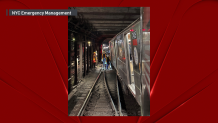Feds to investigate entire NYC subway system after derailment injures more than 20
What to Know
- An investigation is underway after a northbound commuter 1 train collided with an out-of-service train leading to a minor derailment just north of the 96th Street station on the Upper West Side
- At least 26 people suffered minor injuries, according to the FDNY. Three hundred people had to be taken off the train that derailed and another 300-400 had to be taken off a train behind the ones that collided
- Service on the 1/2/3 subway lines was seeing some signs of progress heading into the weekend, with the 1 and 3 lines getting limited service back with the help of buses
Federal transit safety investigators will be reviewing all of New York City's subway operations in response to Thursday's collision and derailment[1] that caused minor injuries to more than 20 people, the chairperson of the National Transportation Safety Board said Friday. Chair Jennifer Homendy said the NTSB had concerns because this week's collision between two trains was the second serious subway episode in Manhattan in just over a month.
On Nov.
29, a subway worker for the MTA was dragged under a train and killed while working as a rail safety flagger. "This is the second accident on New York City transit's property in 37 days. That's not typical," Homendy said at a news conference at the 96th Street station, where Thursday's collision happened. "The NTSB has been very focused on system safety ... so coming here we are going to want to look at the entire system, including how it is managed and supervised."
Homendy said later Friday that the NTSB typically reviews a company's entire operations and safety protocols in its investigations. Pat Warren, the MTA's chief safety and security officer, said the agency was aware of the NTSB's comprehensive approach. "For a subway system that schedules 2.7 million train trips a year, covering 345 million miles annually, this derailment was a rare occurrence that points to the safety and resilience of transit in New York," Warren said in a statement Friday night.

The low-speed crash on the Upper West Side took place at about 3 p.m. on the 1, 2 and 3 lines.
Homendy said an out-of-service train with a few MTA workers aboard struck another train carrying about 300 passengers at a rail switch, causing both trains to derail. Workers on the out-of-service train had been making repairs after someone pulled a number of emergency stop cords and disabled the train. After resetting most of the brakes and disabling others, the workers were trying to get the train to the 240th Street railyard when the collision occurred, Homendy said.
There were no early indicators of a cause, she said. At least 18 people were said to have minor injuries in the derailment, according to the FDNY. The passenger train was evacuated.
Asked about whether there were signs of human error, Homendy said it was still unclear but added, "It's easy to blame humans. Human error is a symptom of a system that needs to be redesigned." Earlier in the day, NYC Transit President Richard Davey said the passenger train had the green light to proceed Thursday but the disabled train did not. "As a result, it bumped into the train," he said. "Why, we don't know, that's still under investigation."
Work crews had been laboring to lift hulking rail cars back on the rails on Friday. Davey said getting them back on the rails in the aftermath was complicated because of the subway tunnel's low ceiling. Transit workers are "literally lifting it a few inches, shimmying it over, lifting it a few, shimmying it over," Davey said. "So that process takes a while."
Our crews have repaired a train that derailed at 96 St on the 1/2/3 lines.
Now that it's been moved, they are inspecting tracks and infrastructure to determine what repairs are needed. There are still significant impacts to service. Details: pic.twitter.com/GzYTPLyGjR[2]
-- NYCT Subway (@NYCTSubway) January 6, 2024[3]Homendy said the subway system does not have cameras and data recorders that could help investigators.
She said the NTSB recommended those devices nationwide to another federal agency in 2015, but the proposal has not been approved so the devices are not required. Thursday's collision caused major service disruptions on the 1, 2 and 3 lines that stretched into Friday. New York Gov.
Kathy Hochul said limited service[4] on those lines was expected to resume at 5 p.m., and the 96th Street station was to reopen. The 2 train had been diverted to Manhattan's east side. Derailments and crashes in the 119-year-old New York City subway system are rare.
The worst crash in city subway history happened on Nov.
1, 1918, when a speeding train derailed in a sharply curved tunnel in Brooklyn, killing at least 93 people.
More recently, five people died on Aug.
28, 1991, when a 4 train derailed at Manhattan's 14th Street Union Square station.
That train's motorman was found at fault for alcohol intoxication and served 10 years in prison for manslaughter.
References
- ^ Thursday's collision and derailment (www.nbcnewyork.com)
- ^ pic.twitter.com/GzYTPLyGjR (t.co)
- ^ January 6, 2024 (twitter.com)
- ^ limited service (www.nbcnewyork.com)